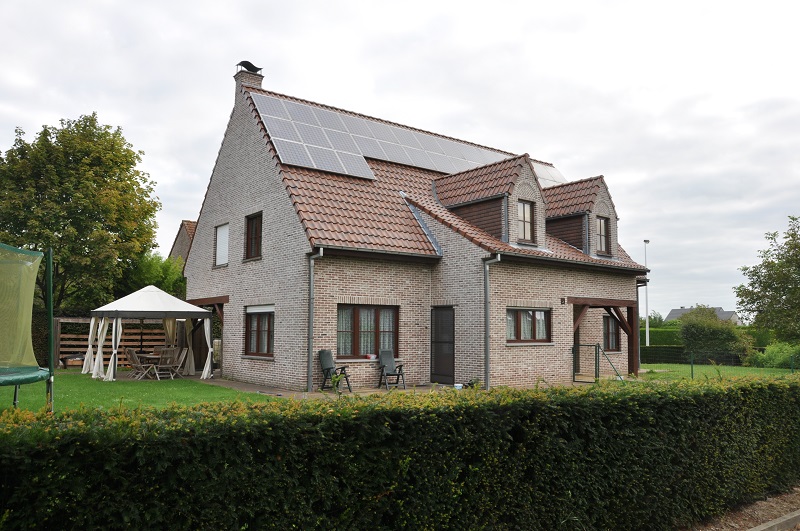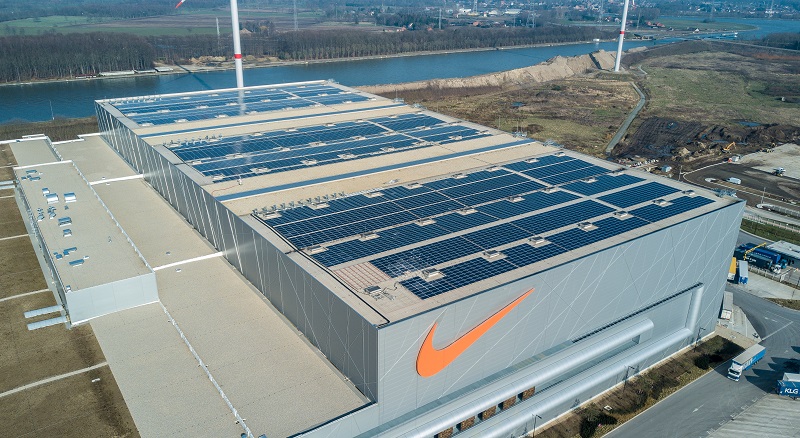Where strong political will meets a drop in deployment costs, is where Belgium’s 2017 solar story starts.
Last year, the European nation upped its cumulative solar capacity by 271 MW to reach 3.8 GW, according to official data from the national renewable energy association APERe. Considering Europe’s 2017 solar installations of 8.61 GW, Belgium’s contribution may seem modest, but it is the surge in solar deployment of over 50% from 179 MW in 2016 that has hogged the limelight.
Backed by net metering, small installations (<10 kWp) accounted for 84% of the newly added capacity. With around 11.4 million inhabitants, solar PV power per capita reached 337 Wp, whereas now with 453,000 small systems online and 4.828.000 households, nearly one out of 10 homes in Belgium owns a PV system!
Each of the country’s three regions, Flanders, Wallonia and Brussels Capital Region enjoys a high level of autonomy, with its own energy system and renewable energy policy. Last year, however, all energy ministers joined forces for a Belgian Energy Pact, which envisages a nuclear exit in 2025, with the prior installation of an energy mix based on gas and renewables, primarily wind and solar. Under the Pact, renewable energy is expected to cover 40% of total consumption by 2030 and 100% by 2050.
Combined with the planned closure of a few older gas-fired power stations, two thirds of the country’s current electricity production is set to disappear nearly overnight. Meanwhile, Belgium’s cumulative installed PV capacity is expected to grow, and according to Belgian grid operator Elia, could reach 11.6 GW by 2030 and go up to 18 GW by 2040.
But this is where the story of a single country ends, and a three-pronged one on constituent regions begins, which aside from their love for chocolate, waffles and beer, do not share much in common.
Flanders – the story of government commitment
Today, Flanders hosts 73% of Belgium’s installed PV capacity, while 57% of the Flemish installations are small systems (≤ 10 kW) entitled to net metering. In 2017, the Flemish residential solar market grew by 193 MW, according to APERe, emerging as the main driver behind the country’s strong growth. This year is poised for further support for mid-sized solar systems from 40 to 750 kW, which will receive green certificates (GC) with a value of about €66/MWh for 10 years, compared to the current €42/MWh for 15 years.

Image: Nyrstar
“Currently we see very little development in the 250 to 750 kW market, but as of April these systems will get better support through the GC market. We expect this will increase the return on the investments in these systems and hence accelerate their uptake,“ says Bram Claeys, the head of local solar association PV Vlaanderen.
Last year also saw the first MW-sized PV project (2.2 MW system on a Nike distribution center) since the revision of the GC scheme in 2013, when PV projects over 10 kW were excluded from the program. The system was inaugurated by the Flemish Minister of Energy, Bart Tommelein, who is touted to know how to make a solar-friendly climate.
“Even with weaker support conditions (unlike Wallonia and Brussels, the region has a prosumer tariff of around 100 €/kW a year), Flanders installs a lot. The minister Tommelein has succeeded in creating this positive atmosphere” comments Gregory Neubourg of APERe.
In addition to a series of initiatives to support C&I rooftop PV development across the region, the Flemish minister announced early this year that Belgium was in line for its first ground mounted solar park since 2013 – 100 MW Kristal Solar Park, which will be incomparably bigger than any other previously installed in the country.
“There are already a few ground-mounted projects, but never bigger than 2-3 MW. Density of population is quite high in Belgium and the price of land is high, and these are the main deterrents for ground mounted systems” says Neubourg, reflecting on the 100 MW project, which is set to sell all of its generated power to local zinc and lead producer Nyrstar, over a 15-year period at a provisionally set rate of €78/MWh.
In terms of smart grid, the Flanders region plans to launch a virtual net metering scheme Zonnendelen. Offering an opportunity to electricity consumers to buy a share in a net metered installation owned by a third party, and thus reduce their energy bills, is seen by Minister Tommelein as the next and most logical step to ensure that more solar panels and especially larger PV plants are added.
“As it is still unclear what the virtual net metering scheme will look like, it is very difficult to assess its potential impact on the Flemish solar market, but it is certainly a great opportunity” says Claeys, noting that it will be very important to safeguard this possibility in the new European renewable energy directive currently under discussion in Brussels.
Overall, Flanders is striving to meet the 2020 target for solar of 3,544 GWh, which was increased last year from 2,670 GWh, after the regional government decided to make up for the missing production from a 556 MW biomass power plant declared bankrupt, by increasing solar and wind power targets by one third.

Image: Elia System Operator
Wallonia – the story of lower pace
The French speaking southern region, which accounts for 25% of Belgium’s solar fleet, has a much bigger share of small installations in its accumulated PV capacity, reaching 82%. Last year, Wallonia’s small installation market saw a recovery, though a less impressive one compared to Flanders. According to APERe’s statistics, over 5,600 new systems came online, equivalent to more than 33 MW, pushing the region’s combined capacity to 972 MW.
Popular content
The main news coming from the region, however, caused concern. The government’s confirmation of closing the residential PV incentive scheme Qualiwatt, under which 90 MW of PV capacity was installed between 2014 and 2017, was seen as a threat to the newly established pace of installation, despite Minister of Energy Jean-Luc Crucke’s claims that PV systems were so profitable today that the incentive program became redundant.
Namely, the Qualiwatt scheme allows owners of residential PV systems (≤10 kW) to receive deductions on their electricity bills proportionate to household income. For the first half of 2018, the deduction ranges from €96.9 per kW installed, to €147.8 per kW, depending on the energy provider, with the goal to ensure an investment return in eight years, and a 5% profitability rate (6.5% for homeowners with low-income) for a 3 kW system.
Wallonia’s energy regulator CWaPE warned that the psychological effect of the incentive’s absence on the potential producers must not be neglected.
“At the moment, the deployment rhythm is increasing and we count 6,000 new installations in 2016 (same trend in 2017) out of 12,000 (maximum annual number of set by the government),“ says CWaPE, adding that the absence of incentives also means no quality assurance regarding the installations, and brings problems for the traceability systems.
Another looming change for the region will be a grid-fee for residential PV system owners starting from 2020, which will range from €330 to €560.
“Wallonia is now in the middle of similar discussions that happened in Flanders earlier, causing unrest in the market,“ says Claeys, noting that meanwhile in the northern region, residential systems are profitable without any other support than simple net metering.
While Flanders is now slowly recovering from a period of rapid decline after overnight cuts to subsidy programs, as the past three years have shown a steady and increasing growth after the peak years of 2009-2011, followed by a market crash in 2012-2015, Wallonia is still in this transformation period.
“For small systems, Wallonia is struggling with her past. The reduction of support (GC from 15 to 10 years) for existing prosumers has had a real negative impact on public opinion, and politicians are still trying to find a solution. As long as this question isn’t resolved, there will be no positive atmosphere like in Flanders,” notes Neubourg, adding that there will for sure be a rush before the scheme’s end on July 1, followed by a downturn.
When asked about the lower solar deployment rate compared to Flanders, the CWaPE simply says that the solar PV deployment began later in Wallonia. Moreover, it says the decrease in the granting period for GCs from 15 to 10 years for the residential solar PV (≤10 kW), which came into force in 2015, had a negative impact on the confidence of (potential) producers and the Qualiwatt scheme in the first months/years.
Meanwhile, one of the drivers of the strong 2017 was the CWaPE’s decision, once the yearly quota for solar PV (> 10 kW) of 52.000 GCs was reached, to remove the 50% ceiling for solar in the inter-sector envelope; an additional quota reserved for renewables in high demand, and release another 155,488 GCs for this type of installation.
“At the moment we count 1300 installations above 10 kW, and this number is still growing” says CWaPE on the C&I segment, which currently accounts for only 15% of the the region’s accumulated capacity.
Brussels – the story of its own
A big change was brought about in the solar arena of the Brussels Capital Region at the start of 2018, with the suspension of net-metering for RE installations (max. 5kW), which were required to have two different meters, a bidirectional one installed by local utility Sibelga and the one measuring the plant’s electricity generation certified by energy regulator Brugel.
The share of home PV owners affected by the decision is overall much smaller than in the other two regions, as only 17% of the Brussels’ 62 MW accumulated capacity comes from installations under 10 kW. In 2017, Brussels maintained its annual pace of small installation additions at 5 MW.
“The high percentage of large installations is mainly due to a very generous support scheme for these plants in 2012. It is still very generous and we see big plants growing again,” said Neubourg, commenting on the 82% C&I solar share in the region’s solar fleet.
While household PV will from now on rely only on direct subsidies in the form of GCs with a guaranteed minimum price of €65, the companies, depending on their size, can count on an investment assistance ranging from 20% to 40% of the eligible costs, holding the promise for further growth.
This content is protected by copyright and may not be reused. If you want to cooperate with us and would like to reuse some of our content, please contact: editors@pv-magazine.com.



Indian company borosi glass inveted world thinnest glass for solar rooftop pvsheet.this glass is very thin and that can change conversion ratio drastically.
With proper storage device like li battery solar power is game changer for green energy